Effects of Playing Music during PE on Intrinsic Motivation of Students
Abstract
1. Introduction
2. Materials and Methods
2.1. Research Design
2.2. Measurement Instrument
2.3. Participants
3. Results
3.1. Quantitative Results on Student’s Intrinsic Motivation
3.2. Quantitative Results on Student’s Intrinsic Motivation
“In fact, I also felt more motivated during lessons with music. I think it also depends on the kind of music played. The genre I mostly heard was hip pop music, which gives us a mental boost and makes us more active”.
“Music encourages us to spontaneously move the body more”.
“Most pupils like music and the combination of sports and music makes us more engaged”.
“You no longer stand still between exercises but sing and dance along with the songs”.
“Music causes a certain substance to be released in the brain that makes us feel more energetic and happy because of those songs with tempo”.
“Music makes me happier, which also allows me to have more fun”.
“When you hear music like the kind that was played you get a confidence boost because of the rhythms”.
“Music distracts and makes us compare ourselves less with others. Thanks in part to the relaxed atmosphere and team spirit, we also feel more competent”.
Yet another student commented: “Music gives energy, so students are going to put much more effort into achieving certain goals than when there is no music”.
“PE still remains a compulsory subject. So pupils don’t really have the choice not to participate”.
“Music doesn’t change the choices we have”.
“Personally, I felt less pressure and was more relaxed during class with music”.
“Music doesn’t necessarily change the pressure put on pupils. The need to perform is still there”.
“During competitions, no one wants to disappoint their teammates and everyone does have a bit of a fear of being told off or mean, so some pressure remains”.
“The physical education subject is a compulsory subject in the curriculum of participating students and therefore a student cannot really choose whether to participate or not”.
“This rather depends on the peers or the teacher himself to what extent pressure is imposed”.
“I would have thought that girls would have a bigger difference in motivation, since girls sometimes don’t like to play sports, but with music they like to play sports. With boys, you would think this difference would be less”.
“The difference in motivation without and with music does not really depend on your gender, field of study or year of study, but rather on your personality”.
“Girls and boys today usually have the same motivation, enjoyment and free choices in everyday life. This is no different in PE class”.
“For both boys and girls, PE class is a pleasant break during a mostly boring school day”.
“Some girls are more motivated than other girls and some boys are less motivated than their gender counterparts, but overall the average motivation is the same. In terms of choices, it is indeed the same for both genders, as no choices were offered for either gender”.
“I didn’t expect there to be no difference in the lesson without music. I did expect the boys to feel more competent than the girls, because girls are generally a bit more insecure than boys, especially when it comes to physical abilities”.
“I think music has a bigger impact on boys’ mindset. I think boys experience music as an extra encouragement and therefore think they play better”.
“I thought girls experience more pressure during PE classes anyway. I think this result can be explained by the boys’ competence. If the boys think they are going to play better, they also radiate this and girls probably feel more pressure to match this performance”.
“I think it’s because sixth-form students are a bit done with school. I think our motivation is a bit lower. It’s time for another step into higher education”.
“I think this makes sense because the physical education class is the same across all study orientations. I think the study orientation is separate from the PE class and therefore it doesn’t make a difference”.
“I think this is because we are all still in the same year and experience this similarly. Music doesn’t have much to change this I don’t think”.
4. Discussion
5. Conclusions
Author Contributions
Funding
Institutional Review Board Statement
Informed Consent Statement
Data Availability Statement
Conflicts of Interest
References
- Waddington, I. Sport and Health: A Sociological Perspective. In Handbook of Sports Studies; SAGE Publications: Thousand Oaks, CA, USA, 2000; pp. 409–422. [Google Scholar] [CrossRef]
- World Health Organization. Global Action Plan for the Prevention and Control of Noncommunicable Diseases 2013–2020; World Health Organization: Geneva, Switzerland, 2013. [Google Scholar]
- World Health Organization. Obesity and Overweight. 2021. Available online: http://www.who.int/news-room/fact-sheets/detail/obesity-and-overweight (accessed on 30 March 2023).
- Vlaanderen, S. Vlaamse Monitor Sport en Bewegen. Available online: https://www.sport.vlaanderen/kennisplatform/thema-sportparticipatie/db-vlaamse-monitor-sport-en-bewegen/ (accessed on 30 March 2023).
- Miranda, D. The role of music in adolescent development: Much more than the same old song. Int. J. Adolesc. Youth 2013, 18, 5–22. [Google Scholar] [CrossRef]
- Papinczak, Z.E.; Dingle, G.A.; Stoyanov, S.R.; Hides, L.; Zelenko, O. Young people’s uses of music for well-being. J. Youth Stud. 2015, 18, 1119–1134. [Google Scholar] [CrossRef]
- Dearn, L. Young People and Popular Music Culture: The Impact of Popular Music within the Everyday Lives of Children Aged 10–16. Master’s Thesis, University of York, York, UK, 2013. [Google Scholar]
- De Frère, U. Welk Effect Heeft Muziek op de Fysieke Activiteit van Studenten Middelbaar Onderwijs Tijdens de Lessen Lichamelijke Opvoeding? in Multidisciplinary Institute for Teacher Training (MILO); Vrije Universiteit Brussel: Brussels, Belgium, 2020. [Google Scholar]
- Petruzzellis, L.; Chebat, J.-C.; Palumbo, A. “Hey Dee-Jay Let’s Play that Song and Keep me Shopping All Day Long”. The Effect of Famous Background Music on Consumer Shopping Behavior; Springer: Cham, Switzerland, 2015. [Google Scholar]
- Milliman, R.E. The Influence of Background Music on the Behavior of Restaurant Patrons. J. Consum. Res. 1986, 13, 286–289. [Google Scholar] [CrossRef]
- Engels, R.C.M.E.; Poelen, E.A.P.; Spijkerman, R.; Bogt, T.T. The effects of music genre on young people’s alcohol consumption: An experimental observational study. Subst. Use Misuse 2012, 47, 180–188. [Google Scholar] [CrossRef]
- Gangrade, A. The Effect of Music on the Production of Neurotransmitters, Hormones, Cytokines, and Peptides: A Review. Music. Med. 2012, 4, 40–43. [Google Scholar] [CrossRef]
- Higginson, K.; Barney, D.; Prusak, K.; Wilkinson, C. The Effect of Music- and Video-Distraction on High School Physical Education Student Exercise Intensity. Phys. Educ. 2019, 76, 907–925. [Google Scholar] [CrossRef]
- Tsang, E.C.K. A Comparison on the Effect of Doing Exercise, Listening to Music and Taking Quiet Rest on Mood Changes. Asian J. Phys. Educ. Recreat. 2011, 17, 37–44. [Google Scholar] [CrossRef]
- Terry, P.C.; Karageorghis, C.I. Psychophysical effects of music in sport and exercise: An update on theory, research and application. In Psychology Bridging the Tasman: Science, Culture and Practice, Proceedings of the 2006 Joint Conference of the Australian Psychological Society and the New Zealand Psychological Society, Auckland, New Zealand, 26–30 September 2006; Australian Psychological Society: Melbourne, VIC, Australia, 2006. [Google Scholar]
- Haluk, K.; Turchian, C.; Adnan, C. Influence of Music on Wingate Anaerobic Test Performance. Ovidius Univ. Ann. Ser. Phys. Educ. Sport/Sci. Mov. Health 2009, 9, 134. [Google Scholar]
- Eliakim, M.; Meckel, Y.; Nemet, D. The Effect of Music during Warm-Up on Consecutive Anaerobic Performance in Elite Adolescent Volleyball Players. Int. J. Sports Med. 2007, 28, 321–325. [Google Scholar] [CrossRef]
- Konukman, F.; Harms, J.; Ryan, S. Using Music to Enhance Physical Education. J. Phys. Educ. Recreat. Dance 2012, 83, 11–56. [Google Scholar] [CrossRef]
- Barney, D.C.; Pleban, F.T. An Examination of Physical Education Teachers’ Perceptions of Utilizing Contemporary Music in the Classroom Environment: A Qualitative Approach. Phys. Educ. 2018, 75, 195–209. [Google Scholar] [CrossRef]
- Deutsch, J.; Hetland, K. The Impact of Music on Pacer Test Performance, Enjoyment and Workload. Asian J. Phys. Educ. Recreat. 2012, 18, 6–14. [Google Scholar] [CrossRef]
- Brewer, L.; Barney, D.C.; Prusak, K.A.; Pennington, T. Effects of Music on Physical Activity Rates of Junior High School Physical Education Students. Phys. Educ. 2016, 73, 689–703. [Google Scholar] [CrossRef]
- Barney, D.; Prusak, K.; Brewer, L. The Effects of Music on Student Step Counts and Time in Activity in College Basketball Activity Classes. Fac. Publ. 2018, 2608. Available online: https://scholarsarchive.byu.edu/facpub/2608 (accessed on 30 March 2023). [CrossRef]
- Barney, D.; Prusak, K. Effects of Music on Physical Activity Rates of Elementary Physical Education Students. Phys. Educ. 2015, 72, 236–244. [Google Scholar]
- Barney, D.C.; Leavitt, T. A Qualitative Investigation of PE Teachers Perceptions of Introductory/Warm-up Activities in K-12 PE. Phys. Educ. 2019, 76, 86–97. [Google Scholar] [CrossRef]
- Barney, D.; Christenson, R. Physical Education Majors Team Teaching in an Early Field Experience in a Junior High School Setting. Asian J. Phys. Educ. Recreat. 2009, 15, 16–21. [Google Scholar] [CrossRef]
- Digelidis, N.; Karageorghis, C.; Papapavlou, A.; Papaioannou, A.G. Effects of Asynchronous Music on Students’ Lesson Satisfaction and Motivation at the Situational Level. J. Teach. Phys. Educ. 2014, 33, 326–341. [Google Scholar] [CrossRef]
- Ryan, R.M.; Deci, E.L. Self-determination theory and the facilitation of intrinsic motivation, social development, and well-being. Am. Psychol. 2000, 55, 68. [Google Scholar] [CrossRef] [PubMed]
- IBM Corp. IBM SPSS Statistics for Windows; IBM Corp.: Armonk, NY, USA, 2019. [Google Scholar]
- Plant, R.W.; Ryan, R.M. Intrinsic Motivation and the Effects of Self-Consciousness, Self-Awareness, and Ego-Involvement: An Investigation of Internally Controlling Styles. J. Personal. 1985, 53, 435–449. Available online: https://psycnet.apa.org/doi/10.1111/j.1467-6494.1985.tb00375.x (accessed on 30 March 2023).
- Ryan, R.M.; Koestner, R.; Deci, E.L. Ego-involved persistence: When free-choice behavior is not intrinsically motivated. Motiv. Emot. 1991, 15, 185–205. [Google Scholar] [CrossRef]
- McAuley, E.; Duncan, T.; Tammen, V.V. Psychometric Properties of the Intrinsic Motivation Inventory in a Competitive Sport Setting: A Confirmatory Factor Analysis. Res. Q. Exerc. Sport 1989, 60, 48–58. [Google Scholar] [CrossRef]
- McAuley, E.; Tammen, V.V. The Effects of Subjective and Objective Competitive Outcomes on Intrinsic Motivation. J. Sport Exerc. Psychol. 1989, 11, 84–93. [Google Scholar] [CrossRef]
- Tsigilis, N.; Theodosiou, A. Temporal stability of the intrinsic motivation inventory. Percept. Mot. Ski. 2003, 97, 271–280. [Google Scholar] [CrossRef]
- Karaoglanidis, D.; Mouratidou, K.; Kanellopoulos, P.; Karamavrou, S.; Parisi, I. Perceived autonomy, motivation climate and intention for physical activity. a comparative study of students based on their gender and educational level. Facta Univ. Ser. Phys. Educ. Sport 2020, 18, 25–36. [Google Scholar] [CrossRef]
- Ghorbani, S.; Nouhpisheh, S.; Shakki, M. Gender Differences in the Relationship between Perceived Competence and Physical Activity in Middle School Students: Mediating Role of Enjoyment. Int. J. Sch. Health 2020, 7, 14–20. [Google Scholar] [CrossRef]
- Cairney, J.; Kwan, M.Y.; Velduizen, S.; Hay, J.; Bray, S.R.; Faught, B.E. Gender, perceived competence and the enjoyment of physical education in children: A longitudinal examination. Int. J. Behav. Nutr. Phys. Act. 2012, 9, 26. [Google Scholar] [CrossRef] [PubMed]
- Yurt, E. Examining high school students’ academic amotivation. Int. J. Curr. Educ. Stud. 2022, 1, 51–63. [Google Scholar] [CrossRef]
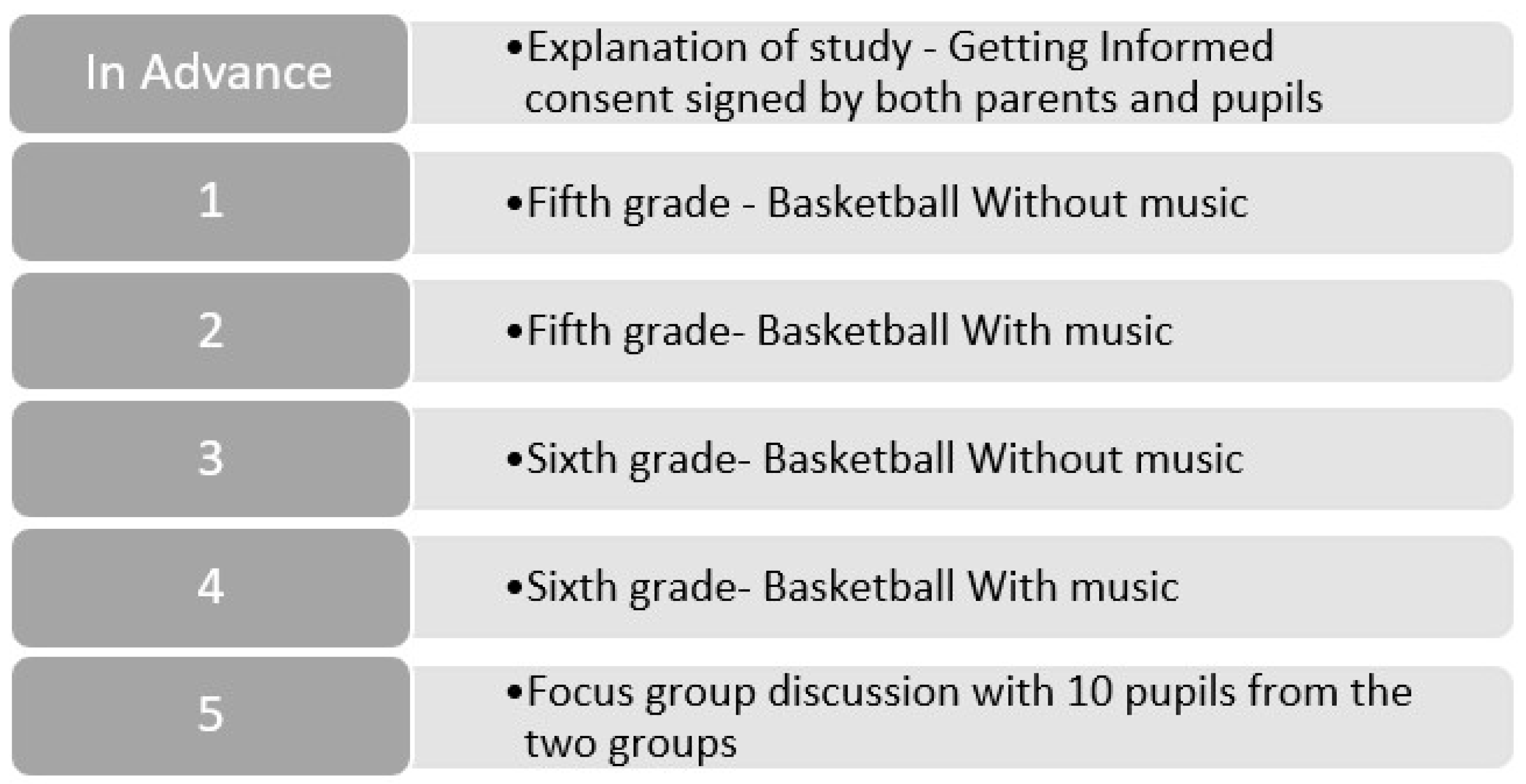
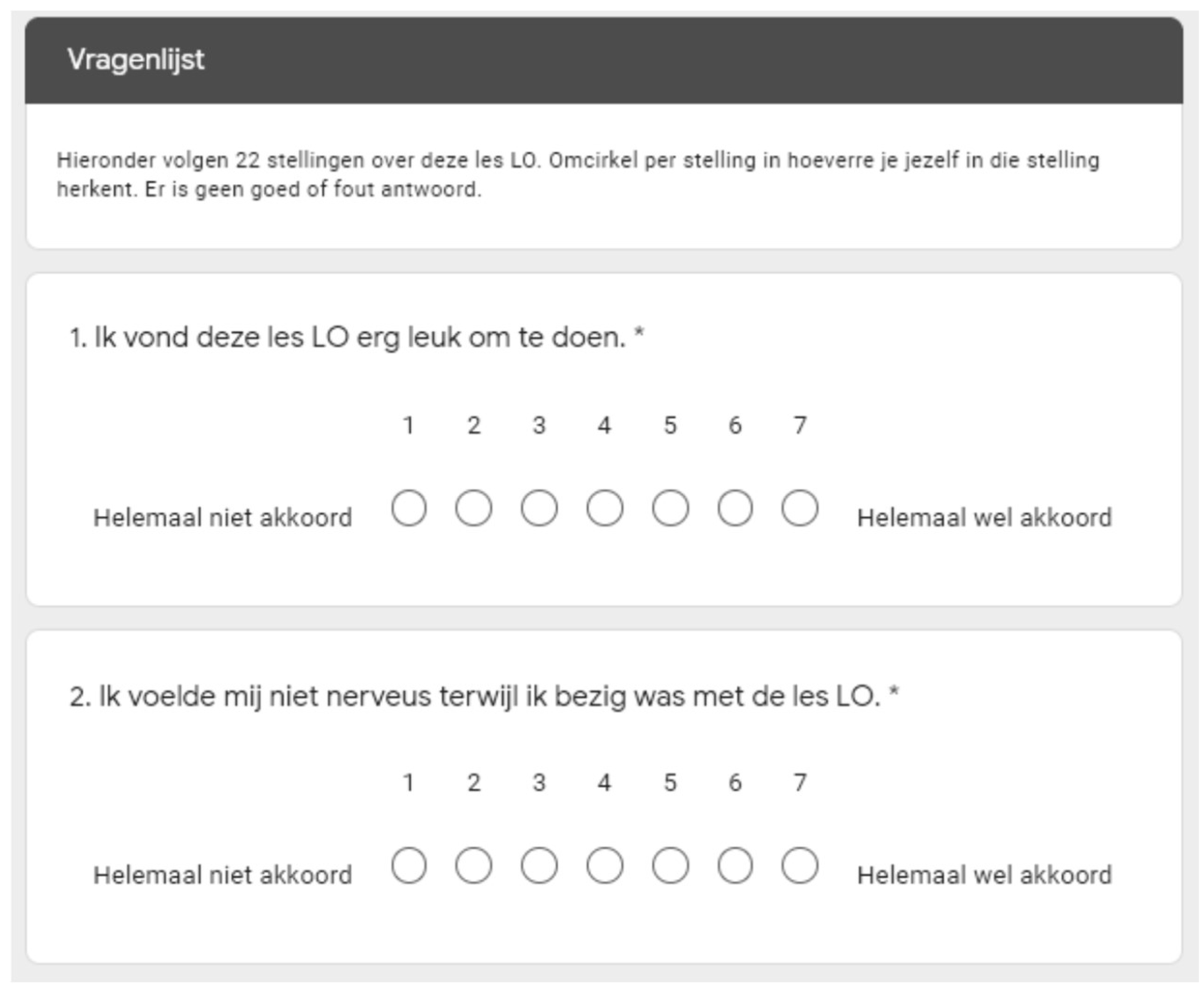
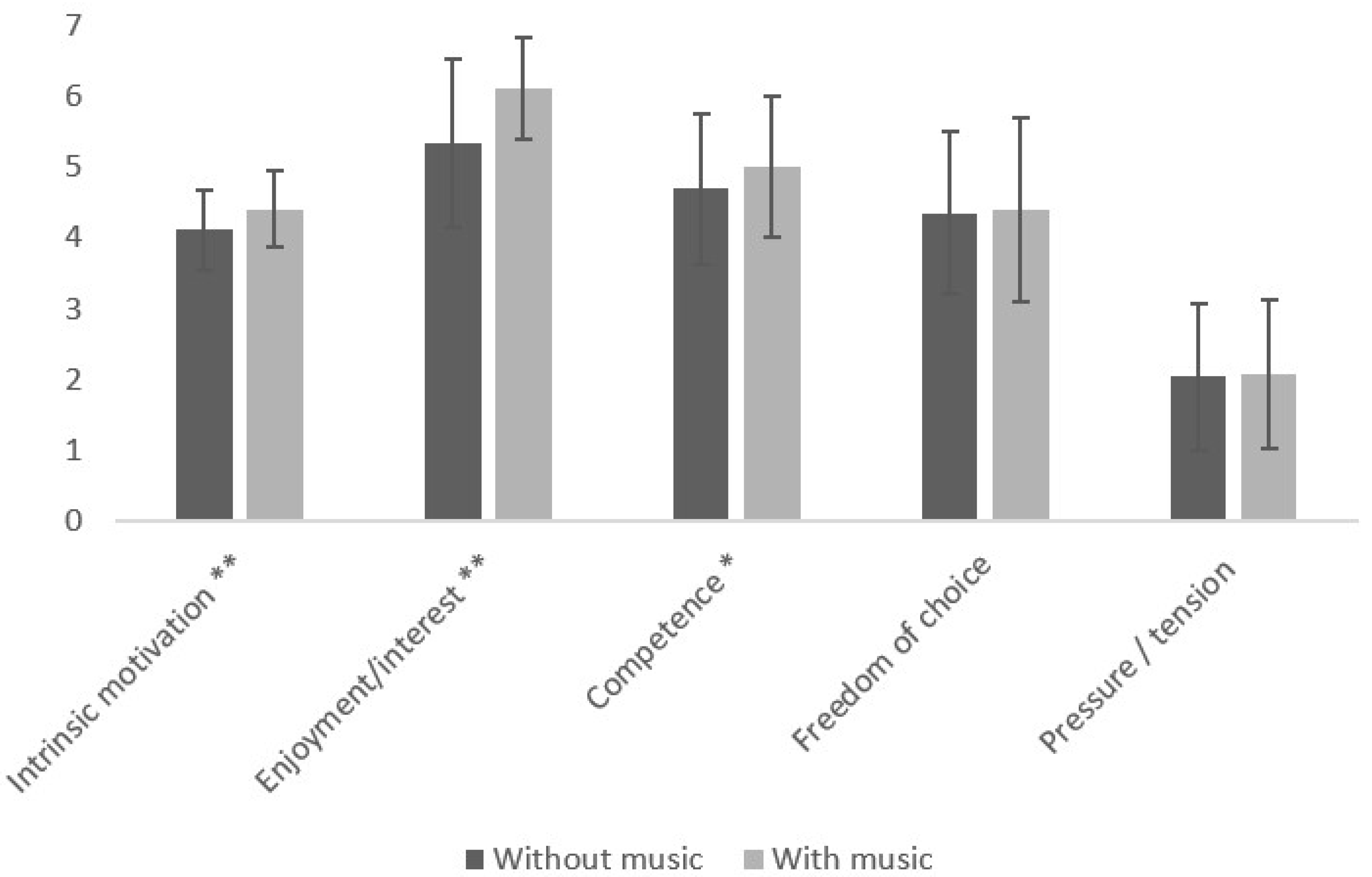
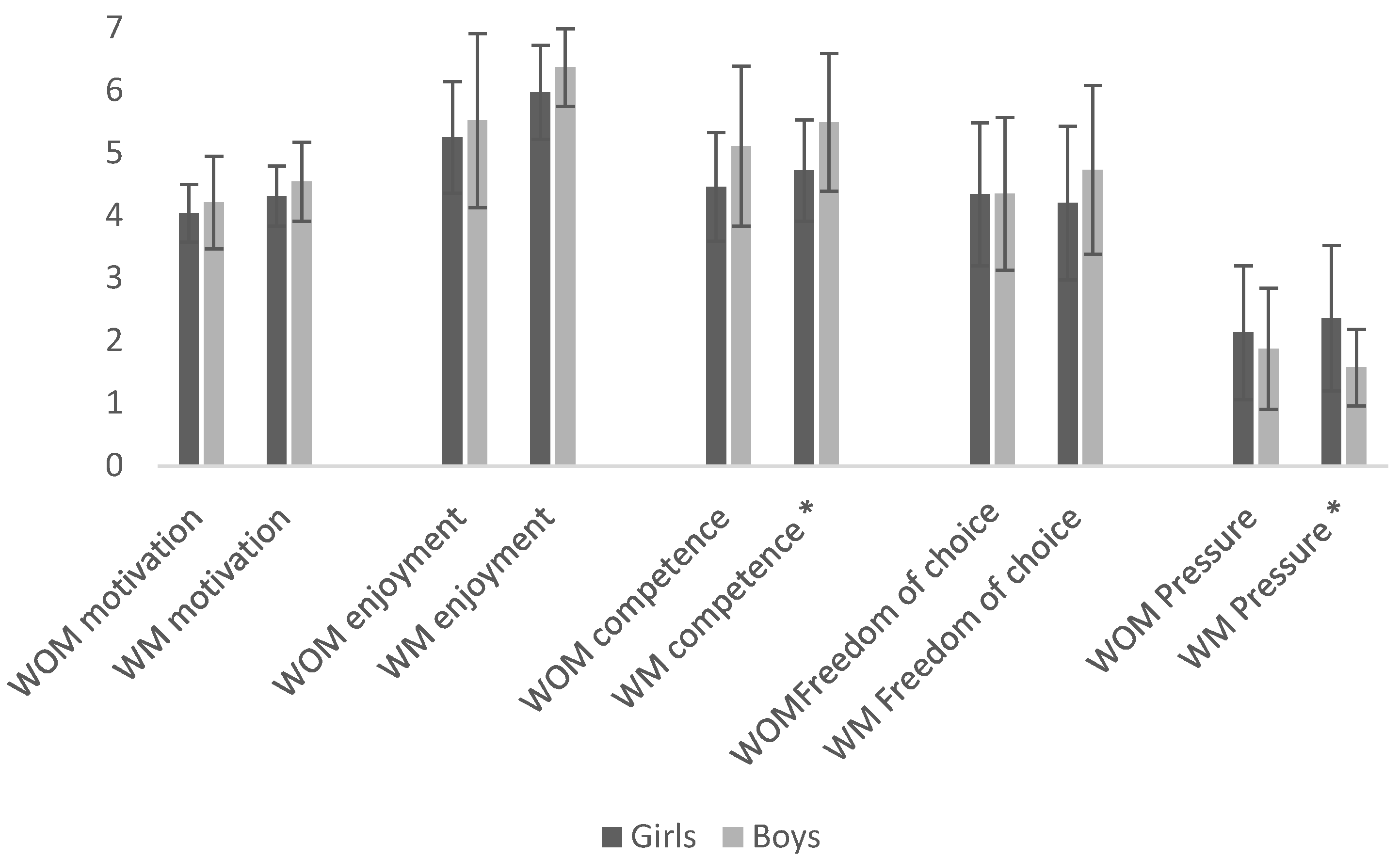
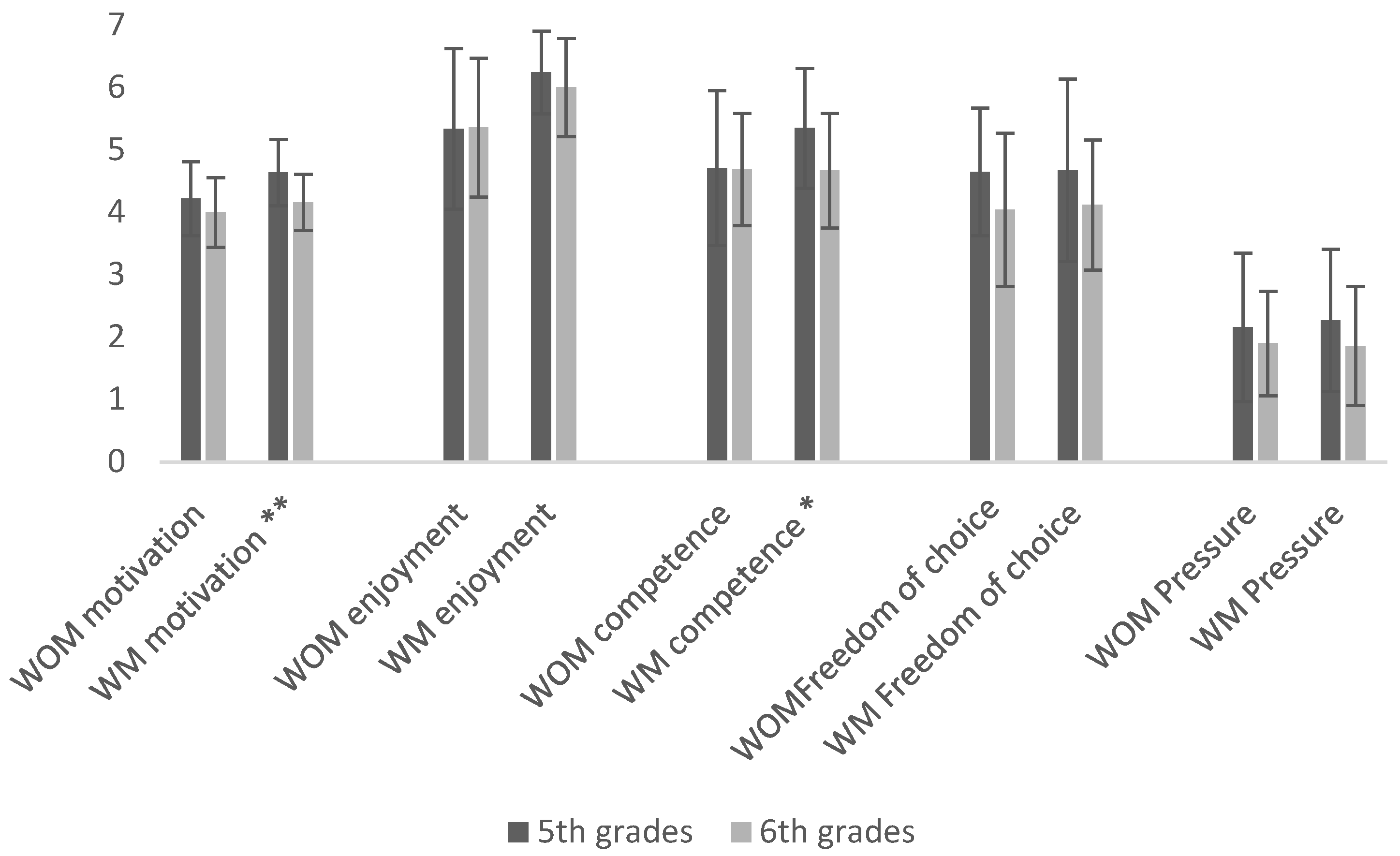
| Subscales | Means/SD | |
|---|---|---|
| With Music | Without Music | |
| Intrinsic motivation ** | 4.11 ± 0.58 | 4.40 ± 0.54 |
| Enjoyment ** | 5.35 ± 1.19 | 6.12 ± 0.72 |
| Competence * | 4.70 ± 1.07 | 5.01 ± 0.99 |
| Freedom of choice | 4.35 ± 1.15 | 4.40 ± 1.29 |
| Pressure/Tension | 2.03 ± 1.03 | 2.07 ± 1.06 |
| Subscales | Items | Mean/SD | Cronbach’s Alfa | ||
|---|---|---|---|---|---|
| With Music | Without Music | With Music | Without Music | ||
| Enjoyment | 7 | 5.35 ± 1.19 | 6.12 ± 0.72 | 0.961 | 0.889 |
| Competence | 5 | 4.70 ± 1.07 | 5.01 ± 0.99 | 0.894 | 0.891 |
| Freedom of choice | 5 | 4.35 ± 1.15 | 4.40 ± 1.29 | 0.571 | 0.745 |
| Pressure/Tension | 5 | 2.03 ± 1.03 | 2.07 ± 1.06 | 0.733 | 0.737 |
Disclaimer/Publisher’s Note: The statements, opinions and data contained in all publications are solely those of the individual author(s) and contributor(s) and not of MDPI and/or the editor(s). MDPI and/or the editor(s) disclaim responsibility for any injury to people or property resulting from any ideas, methods, instructions or products referred to in the content. |
© 2023 by the authors. Licensee MDPI, Basel, Switzerland. This article is an open access article distributed under the terms and conditions of the Creative Commons Attribution (CC BY) license (https://creativecommons.org/licenses/by/4.0/).
Share and Cite
Cools, W.; De Frère, U.; Caplin, A. Effects of Playing Music during PE on Intrinsic Motivation of Students. Youth 2023, 3, 654-670. https://doi.org/10.3390/youth3020043
Cools W, De Frère U, Caplin A. Effects of Playing Music during PE on Intrinsic Motivation of Students. Youth. 2023; 3(2):654-670. https://doi.org/10.3390/youth3020043
Chicago/Turabian StyleCools, Wouter, Ulrike De Frère, and Ariane Caplin. 2023. "Effects of Playing Music during PE on Intrinsic Motivation of Students" Youth 3, no. 2: 654-670. https://doi.org/10.3390/youth3020043
APA StyleCools, W., De Frère, U., & Caplin, A. (2023). Effects of Playing Music during PE on Intrinsic Motivation of Students. Youth, 3(2), 654-670. https://doi.org/10.3390/youth3020043







